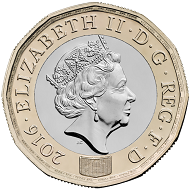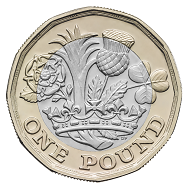April 6, 2017 – Great Britain has introduced the new £1 coin in March 2017. This brings a lot of changes. We have asked Paul Binning of the Royal Mint about the enormous task to help businesses getting ready for the conversion.
Paul Binning, Head of Marketing answered our questions.
CW: You have started a campaign especially for businesses. What will be the main problem for retail businesses?
PB: The new 12-sided £1 coin is being introduced in March 2017, and at The Royal Mint we’ve already been working with key members of industry for more than three years, keeping them informed and listening to their concerns to hopefully allay any major problems.
All retailers will need to check whether they operate equipment that handles the £1 coin. This can vary dramatically from shop to shop, depending on size. Almost everyone has a till, but then there might be automated self-service checkouts, vending machines, photo booths, children’s rides and a myriad of other equipment both in the main shop and the back offices and staff areas that need checking. The bigger retailers will also potentially have parking meters on their land to update too.
We’ve worked hard with the whole supply chain, especially the suppliers of this hardware, to ensure they’re ready to upgrade, and encouraging the retailers to talk to their suppliers to make the necessary arrangements.
Retailers will then need to train their staff on the features of the new £1 coin in order that they recognise them after the new coin’s introduction. We’ve produced materials to support staff training, and these are available to download for free. This includes leaflets and videos.
Retailers also need to think about and agree with their bank or cash in transit (CIT) provider how they will return the current £1 coin and receive the new £1 coin during the six-month co-circulation period.
CW: You write that you are working collaboratively with a number of industries and key businesses to ensure a smooth transition. Can you state what kind of industries and businesses are involved and how long has been the forerun period to ensure this cooperation?
PB: Since before the announcement in March 2014 that a new £1 coin was going to be introduced, The Royal Mint has been working with Her Majesty’s Treasury in the UK and consulting with many aspects of the currency handling industry. This includes key organisations in the cash services industry, coin handling equipment manufacturers and representative organisations and companies in sectors with high cash transactions e.g. retail, transport and leisure.
HM Treasury launched a ten-week consultation with the public and industry in 2014 and the feedback received has been critical in planning for the introduction of the coin.
A big benefit is that we were to clearly identify a need for the introduction of a new £1 coin right from the start (a 3% counterfeit rate of the round pound coin) so the vast majority of stakeholders have bought into, understood and thus been appropriately supportive in getting us to this point.
CW: How do you manage the period of co-circulation concerning vending machines?
PB: This is being managed by the vending machine manufacturers, but with the closeness of the relationship we have built up in the past few years with the European Vending Association (EVA) and its members, we are confident they know what is required and they have publicly stated they understand the need for change.
The co-circulation period is a slightly different challenge to the introduction itself as some mechanisms only have eight slots for the eight current coins to drop into, but in many instances plans and upgrades are already completed and each will have different arrangements with their customers as appropriate to them.
The new British 1 Pound Coin.
CW: What would you describe to be the major challenges changing the most important coin of a nation?
PB: The most important aspect of introducing any new coin is ensuring that the public recognises, accepts and is able to use the new coin when it is introduced. As well as a good public education campaign, it is imperative that the entire cash handling industry is prepared for the new coin, and understands their role within the launch.
Within the UK’s cash handling industry, there are more than five million businesses registered so carefully thought out communication and liaison with the key sectors is required to ensure that they understand what they need to do prior to the coin’s introduction. This includes updating equipment, training their staff and thinking about how the money will flow once the new coin has been introduced. The Royal Mint has been central to this for a number of years now and understands its role in helping the country’s currency system remain stable.
The other key challenge is retrieving all of the old coins from circulation – approximately 1.6 billion of them. To ensure integrity, it has been clearly identified that the old £1 coin, which has been counterfeited at rates of around 3%, must be withdrawn and so we have been planning how we retrieve old coins from circulation within a short period of time.
CW: Do you have any facts or figures like how many retail businesses are concerned? How many vending machines have to be modified?
PB: The Automatic Vending Association (AVA) indicates that there are over 420,000 vending machines around the UK. Many of these will need to be adapted for the new £1 coin.
The UK’s Office of National Statistics (ONS) research states that there are approximately 300,000 retail businesses operating in the UK. Staff working in the retail sector all need to know about the new £1 coin.
CW: Which kind of media do you use in order to get in touch with the various target groups?
PB: We’ve tried to use anything and everything we can! On a serious note, to get out to more than 60 million people, we’re having to make the releases as interesting and fun as possible. Introduction of new currency excites people – and, therefore, the media – so we can use that to our advantage. Interest has been high ever since the initial announcement when we made the front page of many of the UK’s national newspapers. The fact that it has our specially-developed new ‘secret’ security feature in the coin has added to the media’s intrigue.
More specifically, for the key target groups we have identified the main trade media to engage with specific target industries e.g. Retail Week, Parking News, The Caterer, etc.
We have also targeted different business sectors through social media by engaging key influencers and using targeted boosts for our key messages about upgrading equipment, training staff and making arrangements for the co-circulation period.
CW: Could you repeat some details of the time table? When did you get in touch with the vending industry and other key businesses? When did you involve retailers? When will the campaign for the broad public start?
PB: By the time of the introduction of the new coin, The Royal Mint will have been liaising with the key stakeholders including manufacturers and the cash industry for over three years.
The Business Communications Campaign commenced in October 2016, five months before the introduction of the new coin, and the public communications campaign has commenced in January 2017.
This will all continue right up to the launch date, through the initial bedding-in period and right throughout the co-circulation period to ensure the smoothest possible transition and to make sure we maximise the retrieval of old £1 coins. Once the old coin is demonetised, it will not be possible to use it in every-day transactions.
And for all information on the new £1 coin click here.
To learn more about UK circulation coins go to the website of the Royal Mint.
This article was first published in Mint News Quarterly 04 / 2016. Mint News Quarterly is issued by Currency News in association with Monea. Editor is Ursula Kampmann.







